Chapter 4. Meaningfulness in Figure - Ground Organization
4.1 Title slide

Meaningfulness in Figure - Ground Organization
Participate in an experiment to assess whether the meaningfulness of shapes affects figure - ground organization.
CLICK ANYWHERE TO BEGIN
Photo: © Design Pics/Corbis.
Does Meaningfulness Influence Figure–Ground Organization?
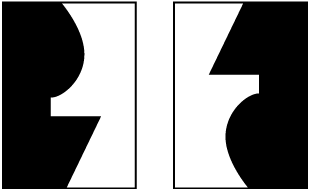
For the image on the left, people are about as likely to say that the white part is figure and the black part is ground as they are to say the opposite, that the black part is figure and the white part is ground. For the image on the right, however, people are much more likely to say that the black part is figure and the white part is ground. This is the case even if the image is shown very briefly—for just 100 milliseconds in the present demonstration and for as little as 28 milliseconds in the original 1994 experiment.
The two images are matched in terms of their visual features, such as the overall areas of the black and white regions, so the best explanation for this result is that the meaningfulness of the shape plays a role in identifying figure and ground. That is, it seems that the visual system recognizes the object before performing figure–ground organization.
Images © Peterson, M.A. & Gibson. B.S. (1994). "Must Figure–Ground Organization Precede Object Recognition? An Assumption in Peril." Psychological Science, Vol 5, issue 5, 253-259. This material is reproduced with permission of SAGE Publications.
4.2 Explain
Each image will consist of a black region on the left and a white region on the right or vice versa.
You might perceive the left or right region as "figure" (that is, as having an objectlike shape) and the other region as "ground"
(that is, as a background for the object like shape).
After you see each image, you'll have to indicate which region looked more like "figure"—the region on the left or the region on the right.

Images © Peterson, M.A. & Gibson. B.S. (1994). "Must Figure–Ground Organization Precede Object Recognition? An Assumption in Peril." Psychological Science, Vol 5, issue 5, 253-259. This material is reproduced with permission of SAGE Publications.
4.3 Explain


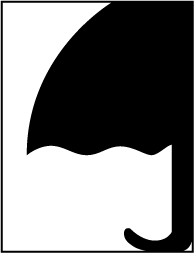
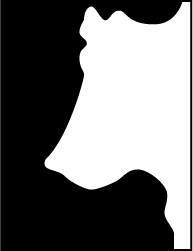
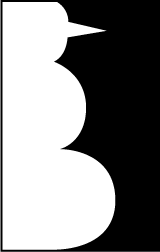

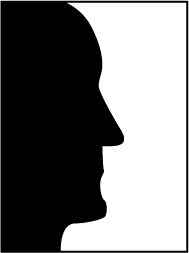

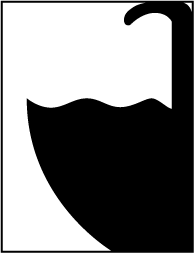
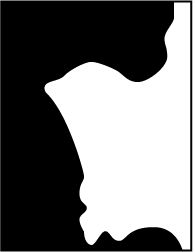
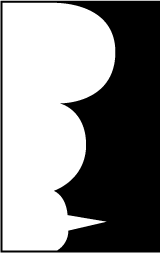

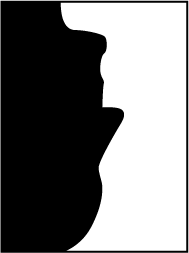
Which region looked more like "figure"?
4.4 Explain
Your results cannot be displayed because you didn't complete all the trials.
You can finish the trials and see your results, or you can proceed to the next screen.
You saw each image for just 100 milliseconds (0.1 second).
Participants in this type of experiment typically identify upright objectlike shapes as "figure" significantly more often
than they identify inverted object like shapes as "figure."
How do your results compare to the typical results?
|
Images with upright objectlike shapes
|

|

|

|

|

|

|
|
Images with inverted objectlike shapes
|

|

|

|

|

|

|
|
Your results
|
Upright objectlike shapes you identified as "figure"
0
Inverted objectlike shapes you identified as "figure"
0
Non-objectlike shapes you identified as "figure"
0
|
|||||
4.5 Explain
Does Meaningfulness Influence Figure–Ground Organization?
It seems reasonable to assume that, in order to recognize an object, we must first identify its shape—that is, we must first perform figure—ground organization, segregating figure from ground so we can assess the figure shape and see if it matches the shape of some object in our memory. However, this assumption appears to be incorrect—that is, it seems that object recognition can occur before figure–ground organization. This was shown in a 1994 experiment by Peterson and Gibson (the experiment on which this demonstration is based). To understand what this observation means, consider the two images below:

For the image on the left, people are about as likely to say that the white part is figure and the black part is ground as they are to say the opposite, that the black part is figure and the white part is ground. For the image on the right, however, people are much more likely to say that the black part is figure and the white part is ground. This is the case even if the image is shown very briefly—for just 100 milliseconds in the present demonstration and for as little as 28 milliseconds in the original 1994 experiment.
The two images are matched in terms of their visual features, such as the overall areas of the black and white regions, so the best explanation for this result is that the meaningfulness of the shape plays a role in identifying figure and ground. That is, it seems that the visual system recognizes the object before performing figure–ground organization.
Images © Peterson, M.A. & Gibson. B.S. (1994). "Must Figure–Ground Organization Precede Object Recognition? An Assumption in Peril." Psychological Science, Vol 5, issue 5, 253-259. This material is reproduced with permission of SAGE Publications.
4.6 Test - single choice
Select your answer to the question below. Then click SUBMIT.
If the image to the right is presented very briefly, why will people be likely to say that the white region on the right is "figure" and the black region on the left is "ground"?
The correct answer is B.
Click EXPLAIN if you want to review this topic.

Image © Peterson, M.A. & Gibson. B.S. (1994). "Must Figure–Ground Organization Precede Object Recognition? An Assumption in Peril." Psychological Science, Vol 5, issue 5, 253-259. This material is reproduced with permission of SAGE Publications.
4.7 Test - single choice
Select your answer to the question below. Then click SUBMIT.
The images to the right show a partial map of the United States. Suppose these images were presented very briefly in random order, as in this demonstration. In which would the white region probably be perceived as "figure"? In which would the black region probably be perceived as "figure"? In which would the black and white regions be equally likely to be perceived as "figure"?
The correct answer is A.
Click EXPLAIN if you want to review this topic.
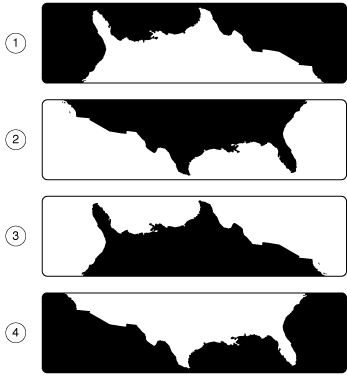
4.8 Test - single choice
Select your answer to the question below. Then click SUBMIT.
Why are the results of the 1994 experiment by Peterson and Gibson noteworthy?
The correct answer is C.
Click EXPLAIN if you want to review this topic.
4.9 Test - single choice
Select your answer to the question below. Then click SUBMIT.
The image on the bottom is identical to the image on top, except that it has been inverted. Assuming that people would be equally likely to see the white area in both images as having the shape of an upright vase, why would you expect figure–ground organization of the two images to differ or not to differ?
The correct answer is C.
Click EXPLAIN if you want to review this topic.
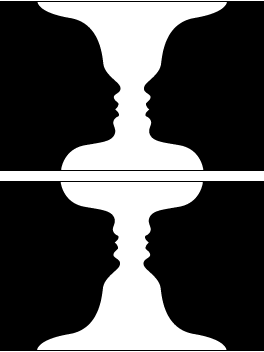
4.10 Activity completed
Meaningfulness in Figure - Ground Organization.